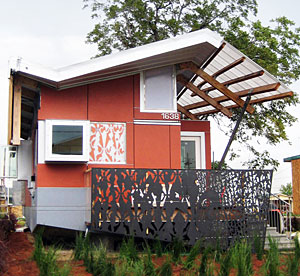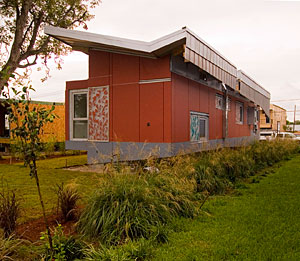

In 2007, actor Brad Pitt’s organization, Make It Right, unveiled its plan to build new homes in New Orleans’ devastated Lower Ninth Ward and hired a roster of modern architects to conceive the designs. Since then, lot owners have been selecting designs by David Adjaye, Shigeru Ban, KieranTimberlake, Trahan Architects, and other locally and internationally renowned architects. Yet future homeowners have not embraced the schemes equally. In fact, none had selected the floatable 1,000-square-foot, single-family house conceived by Morphosis Architects, so studio founder Thom Mayne, FAIA, executed it himself.
Last October, Pitt's foundation unveiled a fully constructed version of that structure in New Orleans. Morphosis worked with UCLA graduate students to design and build the submersible chassis, which was shipped to the Lower Ninth Ward in July. The remaining components were assembled on site.
The base of the so-called Float House is prefabricated in polystyrene foam coated in glass fiber–reinforced concrete, and this buoyant module lifts the entire structure in case of flood; it also contains all power, water, and ventilation systems. The house is secured by guide posts, and may rise 12 feet above its current perch. (Make It Right does not advise potential residents to ride out a hurricane inside.)
Despite zigzagging profiles and abstract ornamentation, Mayne’s design derives inspiration from traditional regional architecture. Like a shotgun house, this building single-loads rooms along a corridor; it also features a raised base that serves as a front porch.
Float House also features structural insulated panels, rooftop photovoltaics, a rainwater collection system, and energy-efficient appliances that should score LEED Platinum, abiding Make It Right’s sustainability standards. Indeed, last September the U.S. Green Building Council announced that the neighborhood the organization is building in New Orleans is the largest and greenest community of single-family homes in the world.
Although hailed for its innovation and widespread applicability to sensitive environments, this first Float House currently awaits a taker.



Post a comment to this article
Report Abusive Comment